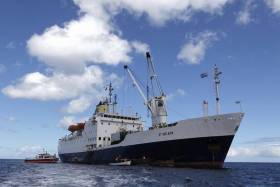Displaying items by tag: AntiPiracy Role
Former RMS St. Helena to Become Anti-Piracy Armory Vessel
#Ports&Shipping- The UK's last working postal ship, RMS St. Helena, was for nearly three decades the main source of contact between one of humanity’s remotest islands and the outside world.
Now the ship, cherished by the 4,500 residents of British-ruled St. Helena, will according to MarineLink, start a new life as a floating armory, packed with automatic weapons, bullet-proof jackets and night vision goggles, all stored for maritime security operatives.
Renamed the MNG Tahiti, the 340-foot ship will undergo some tweaks before sailing to the Gulf of Oman where it will be used to ferry guns and guards to passing vessels navigating stretches of water lurking with pirates, its new operator said on Tuesday.
For more on the story click here and Afloat's reportage in recent years from London where RMS St. Helena made a first and only farewell call to the UK capital. In addition to highlighting a previous historic once-off 'charter-cruise' to Irish ports in 1995.
























































